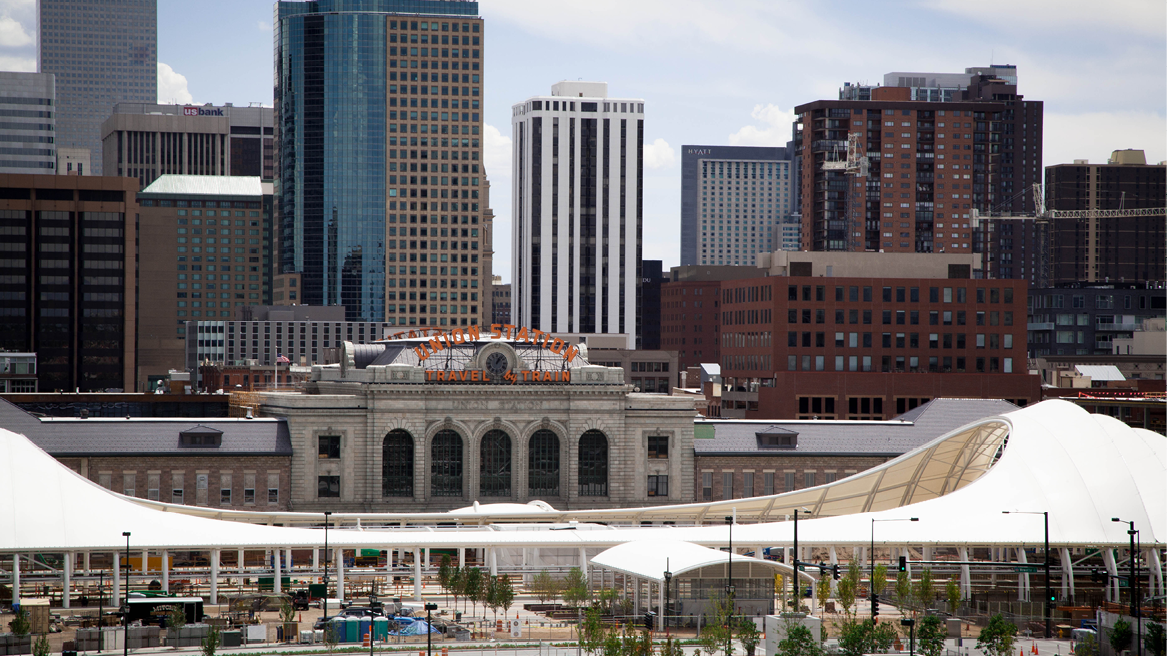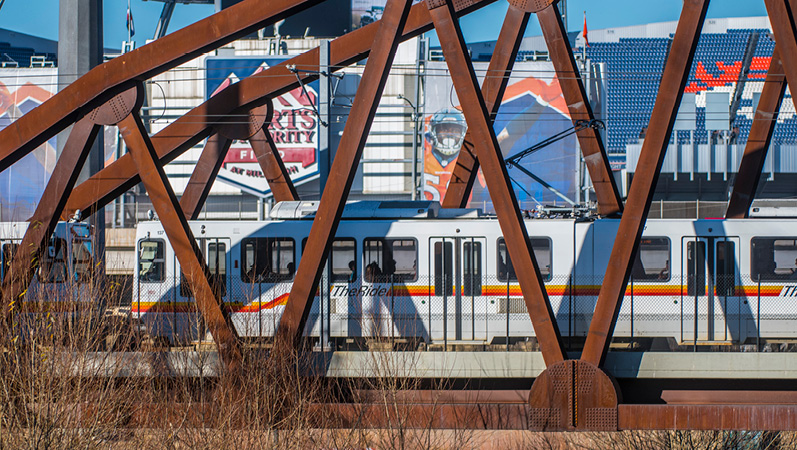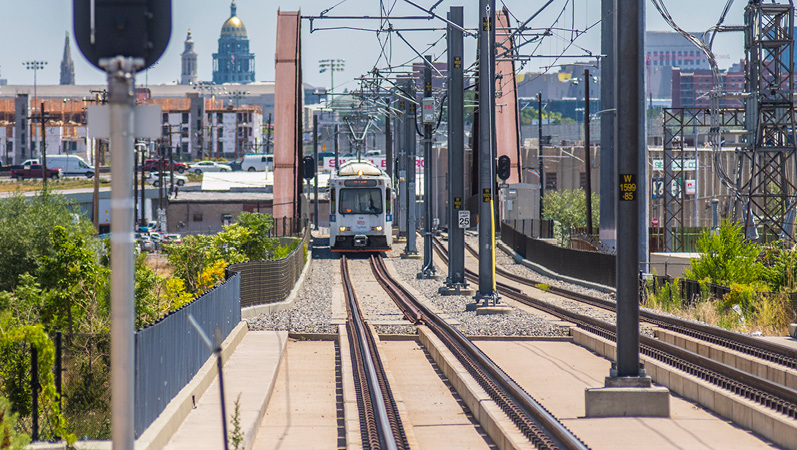It’s often been said that history repeats itself. And in the case of light rail construction, Denver is seeing a glimpse of its past transit system.
Over a 100 years ago, Denver established itself as a driving force in the western United States when it built a railroad spur to connect the city to the Transcontinental Railroad in Cheyenne. The Denver Pacific Railway solidified the region as a center of commerce and industry, and proved that the $800,000 raised by 4,000 residents of Denver to build the railroad connection was a great investment.
Little did they know that the railroad would lay the foundation for the RTD light rail system of the 21st century.
The parallel between the population of Denver and economic boom times, and the growth of RTD’s light rail is like a finely woven piece of fabric. Akin to the early pioneers of Denver, the present day residents of the Mile High City are still recognizing the benefit of being a rail community. Almost 16 years ago, Denver voters approved a sales tax increase to help fund further light rail development (FasTracks). Fast forward to 2020, RTD now offers light rail service on different lines (54 stations and 58.5 miles of track) while commuter rail service ( A and G lines), with 17 stations and 40 miles of track. These stations have also spawned economic development and new places to live across the Denver metro area.
RTD now offers light rail service on different lines (54 stations and 58.5 miles of track) while commuter rail service, with 17 stations and 40 miles of track.
The RTD light rail has not only brought convenient transportation to Denver but is responsible for pop-up residential communities and commercial development along the tracks. At nearly every station on any given line, you’ll find, at the least, new apartment buildings and more often than not, restaurants and services. From Lone Tree to Lakewood to Union Station and many spaces in between, these new communities have been a boon to local economies.
The standout example has been Union Station in LoDo. Just like over a century ago, it serves as the transportation hub of Denver for buses, commuter trains and light rail. But more impressive is the economic impact it created in the neighborhood. Over $2 billion in private investment has been infused into the surroundings with new condos, apartment and office buildings, service providers, retail and restaurants.
According to Reconnecting America, a national nonprofit that integrates transportation and community development, transit-oriented development, or TOD, is a type of community development that includes a mixture of housing, office, retail and/or other amenities integrated into a walkable neighborhood and located within a half-mile of quality public transportation. Successful TOD provides people from all walks of life with convenient, affordable and active lifestyles.
Some of the benefits of TOD include:
- Reduced household driving and thus lowered regional congestion, air pollution, and greenhouse gas emissions
- Walkable communities that accommodate more healthy and active lifestyles
- Increased transit ridership and fare revenue
- Potential for added value created through increased and/or sustained property values where transit investments have occurred
- Improved access to jobs and economic opportunity for low-income people and working families
- Expanded mobility choices that reduce dependence on the automobile, reduce transportation costs and free up household income for other purposes

Each light rail station is now evolving into a center of commerce for the respective communities. Whether developers establish new apartment buildings, hotels, restaurants or service industries, the RTD light rail stations have boosted the economy in each community they serve. In a recent article in Politico, former RTD Phillip Washington was intent on integrating the RTD stations to the local communities.
“I’d always thought that we transit agencies and authorities had to be more than just the T in TOD,” he told Politico in an interview. “If we have a station property, the idea is not go into a community and just independently develop your piece of the pie. We want to work with the community on how to develop it within the fabric of their community, and to my mind that included affordable housing and walkability and nutrition in terms of stores so that it’s not a food desert.”
He pointed to the 10th and Osage station as an example on where they have been able to achieve a healthy balance of new development yet retain the character of the historic Lincoln Park neighborhood. The Lincoln Park Neighborhood has a mix of housing types with a majority of the residences being developed in or before the early 1900s. The community has beautiful parks, mixed-use buildings, an art district, and easy access to grocery stores and public transit. The public transit piece of the neighborhood led directly to the building of Mariposa, a neighborhood of LEED certified townhomes and apartments. There is a central plaza that hosts farmers’ markets and special events and residents enjoy access to playgrounds, outdoor living areas, community gardens and retail space. Despite the development, long time residents have not been displaced and the diversity of the neighborhood continues to exist.

On the south end of the Denver metro area, the Landmark development is an example of a TOD in the suburbs. Positioned between two rail stops, Belleview and Orchard on the I-25 corridor, the community includes the The Landmark Towers condominiums and adjoining commercial area. The Landmark Towers feature 271 condos housed in two high rise buildings just off South Quebec St. Anchoring the area is a development featuring a variety of restaurants, a movie theater, Comedy Works and many services.
According to John Herbers president and CEO of the DTC/Greenwood Village Chamber of Commerce, the Landmark is an example of a community where traffic has been reduced and residents enjoy a variety of services.
“By having communities like the Landmark, you improve the lifestyle and amenities for the residents by having higher density and mixed use,” he said in a recent interview with the Denver Post.. “This is borne out by a study done by consultant for the cities which shows the average household in the Landmark has an average of four car trips per day, where a single-family house in the has 11.”
Several blocks north of the Landmark, you’ll find the Belleview Station and an array of new and under construction office buildings, hotels, apartments, restaurants and fitness operators. This 51-acre site is the last parcel of the original Bansbach family property holdings which at its height amounted to 1,200 acres in southeast Denver and Cherry Hills Village. The Belleview Station masterplan calls for a continued mix of commercial and residential development, along with expanded dining options, new hotels and service providers. Over the last year, several projects have broken ground and the face of the area is quickly changing.
For many communities in Denver, a TOD is the pathway needed to revitalize a city and connect to Denver. Take for example Commerce City. This area that boasts nearly 52,000 people has been best known for the Suncor oil refinery, Rocky Mountain Arsenal and Dick’s Sporting Goods Park, home of the Colorado Rapids soccer team. However, with major roadways — I-25, I-70, 270, Vasquez and Brighton Boulevard — criss crossing the neighborhood, the image of Commerce City has been that of an industrial park as opposed to a neighborhood.
For many communities in Denver, a TOD is the pathway needed to revitalize a city and connect to Denver.
Considering the growth of Denver, especially on the north side, Commerce City is expected to attract 100,000 new residents in the next 20 years. Unfortunately, the RTD has experienced a number of delays with the planned N line which will serve Commerce City and other Denver north suburbs. The most recent update indicates an opening sometime between May-August of 2020. The 13-mile section of the N Line under construction is being built by Regional Rail Partners, a private joint venture, and when completed, will feature eight stations:48th and Brighton, 72nd and Dahlia, 88th and York, 104th and Steele, 112th and York, and 124th and York. Stations at 144th and 162nd will be added later.
The station at 72nd and Dahlia will include 359 parking spots, and a new transit community is in the works. The line will also include a stop at 48th and Brighton Blvd., linking Commerce City with the ongoing expansion and redevelopment of the National Western Complex. And there is little doubt that at all these new stations you’ll eventually see plenty of development, high density housing and a premium on walkability.
Popular Neighborhoods in Denver with Great Access to Commuter Stations
- RiNo – 38th and Blake Station
- Sunnyside – 41st and Fox Station
- Lincoln Park – 10th and Osage station
- Union Station / LoDo – Union Station
- Platt Park / Wash Park – Broadway Station / Louisiana and Pearl
- West Colfax / Villa Park – Perry Station
- University Park / Goldsmith – Yale Station
(Editor’s note: This blog was originally published in June of 2017. It has been updated and edited to provide current information).




